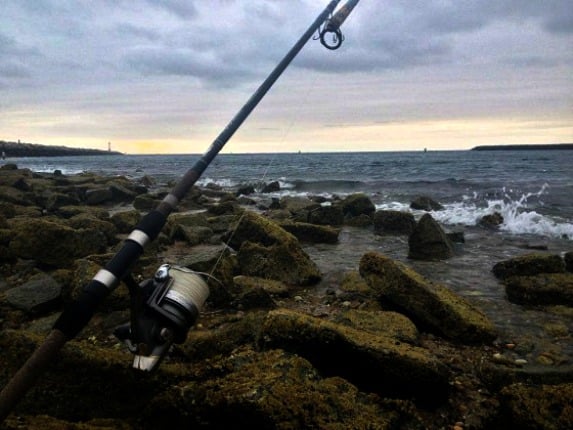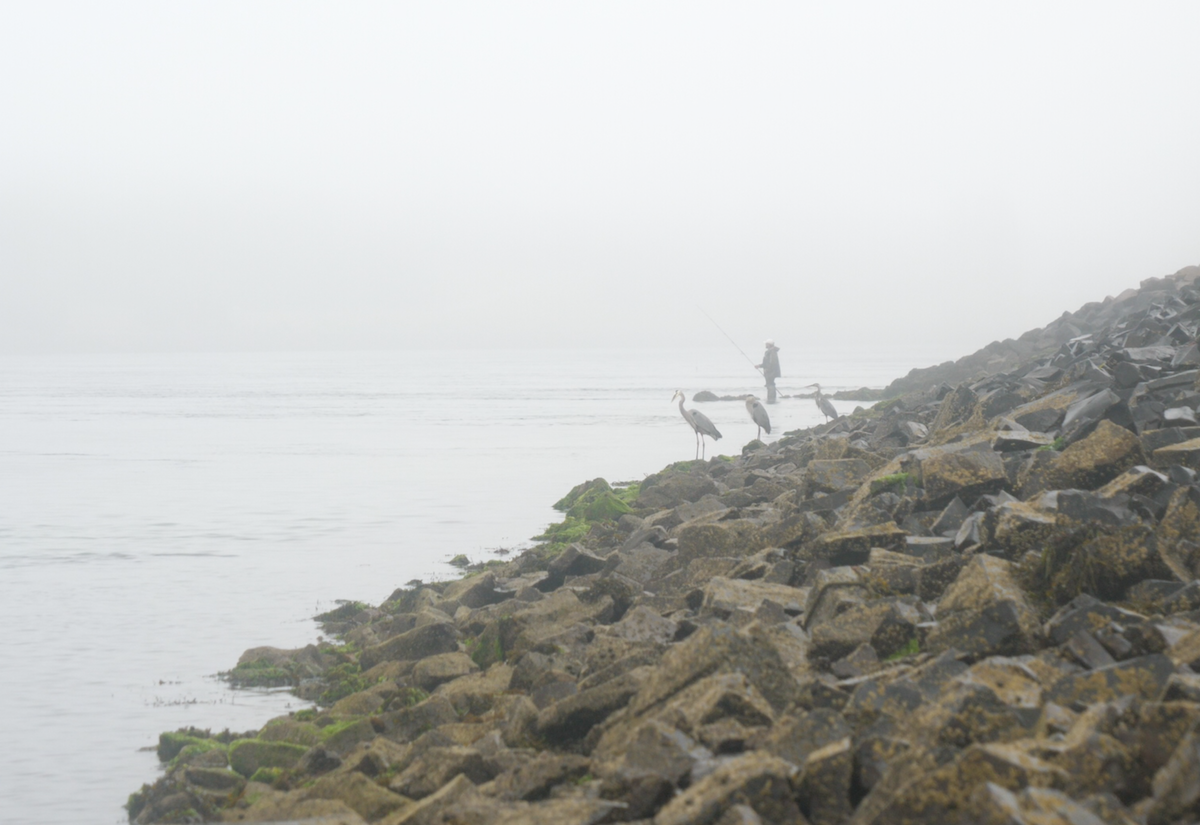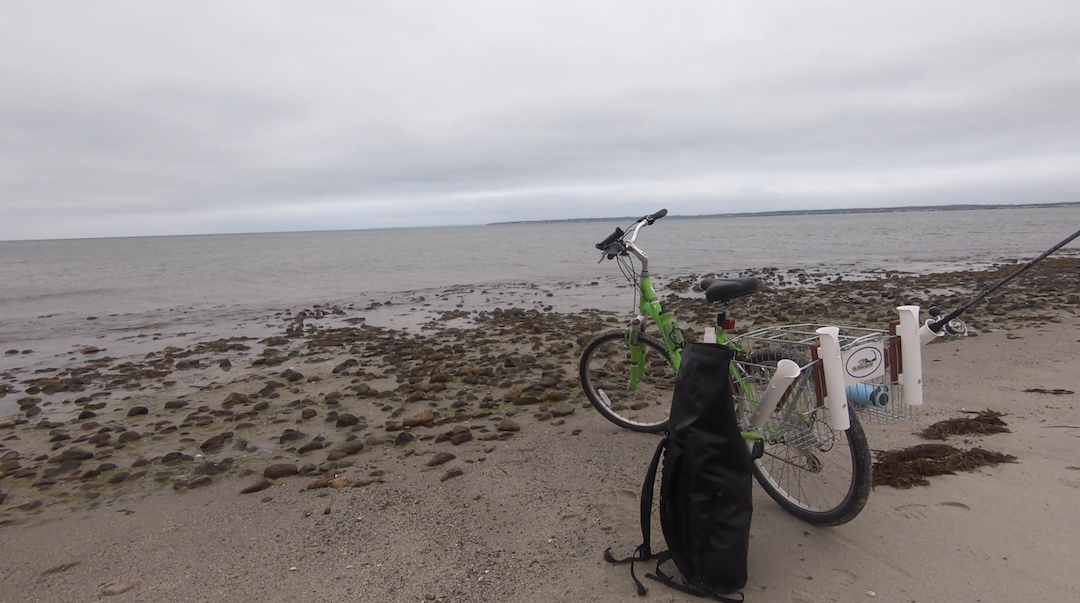If you are serious about learning how to catch striped bass at the Cape Cod Canal, then it's important to understand at least some Canal lingo.
On top of that, if you are hoping to blend in well with the regular Canal fishing crowd, then learning proper Canal etiquette is a must.
The Big Ditch
Each year I receive messages from people wondering where "The Big Ditch" is located, as they think it's a separate spot along the Canal.
Therefore I wanted to start by quickly mentioning that the Canal is often referred to by locals as "The Big Ditch". "The Big Ditch" is simply an affectionate name given to the entire Canal area.
The East & West Ends
First off, the Cape Cod Canal has two "ends" to it. The East End is located at the eastern (actually more of the northern) entrance to the Canal. The West End is located at the western (more like southern) entrance to the Canal.

The East End opens into Cape Cod Bay...

The West End opens into Buzzard's Bay...

There are three bridges that cross the Cape Cod Canal.
Intro to the West & East Tides

We'll discuss tides in-depth in part 5 of this eCourse. Today we'll do a brief overview.
When you hear anglers saying stuff like “the tide turns west at 8am,” they mean that the Canal’s current will start heading in a westward direction at 8am. This is the ebb tide, and the water level within the Canal is dropping.
During the west tide the water level of Cape Cod Bay is higher than the water level of Buzzard’s Bay. This results in Cape Cod Bay emptying water into Buzzard’s Bay until the water level of both bays is roughly equal. It takes about 6 hours for this to occur.
On the other hand if the tide “turns East at 8am” the Canal’s current will begin moving in an eastward direction (into Cape Cod Bay) at 8am. This is known as a flood tide and the water level inside the Canal is rising.
At the end of the ebb and flood tide is a relatively short period of no current. This is known as slack tide.
Using typical tide charts for the canal can cause a lot of confusion. I highly recommend using the current tables from the Army Corp. of Engineers which clearly show the times at which the current turns east and west. See yellow arrow in the above image.
Here is a link to the 2024 Army Corp. Canal Current Table. If you are reading this post after 2024, then simply Google "army corp of engineers cape cod canal current tables for [enter year here]" and the most up-to-date table should appear.
Breaking Tides

One of the more common terms thrown around at the canal is “breaking tides.” Breaking tides occur when a low slack tide happens around sunrise. In other words if the end of the ebb and beginning of the flood occur around sunrise, you have yourself a breaking tide.
I’m not 100% sure how this tidal stage got its name, however I’d be willing to bet that it may have something to do with the behavior of bass during breaking tides. This is conveniently the most probable time to find stripers breaking the surface, feeding aggressively.
We’ll get more into breaking tides later on the eCourse.
Proper Casting Etiquette
One of the more important things to understand when fishing the Canal is how the current will affect your bait or lure. Obviously when you make a cast, your bait or lure will be swept along in the swift current.
How you handle your casting is important, especially if you want to get along with angler’s fishing to the right and left of you.
At the Canal, it is important to work together with the guys to the left and right of you, even if they are complete strangers. To avoid tangles, the down current angler should cast first and place his cast uptide of his position.
Once he has cast his bait or lure, the up current angler should cast his bait or lure. If this rotation is followed both anglers can comfortably fish side by side.
Please watch the video below for more information.
More Courtesy Considerations
There’s plenty of great places to cast a line at the Canal, so unless I personally know an angler, I always try to give them plenty of breathing space.
If an angler up current of your position hooks up with a fish, the rule of thumb is to reel in your line and get out of the angler’s way. At the Canal there is a good chance that the angler’s fish could be 20-50 pounds, so you definitely do not want to do anything to compromise his chances of landing the bass.
Therefore it’s best to wait to cast until the fish is landed, or the angler is well out of your area.
Biking Basics

Here's a photo of my canal bike, which was built by My Fishing Cape Cod member James Passeck!
Another thing to remember is how far your fishing rods stick out from your Canal bike.
A lot of guys ride their bikes up and down the Canal, myself included, which is great. Just be sure to remember how your fishing rod is positioned as you ride or you may snap your rod tip on a tree, bush, or another angler’s fishing pole.
This has happened to me before and I can tell you from experience that there is no dumber feeling in the Canal fishing world then snapping a rod on a tree.
Plugging & Jigging

Topwater plugs, like this My Fishing Cape Cod Guppy Pencil Popper, are excellent choices for early morning fishing at the Cape Cod Canal.
Plugging refers to fishing with wooden and plastic lures at the Canal. Oftentimes these are swimming lures or topwater poppers. Plugging is often most productive during early mornings during breaking tides, but it can also work at other stages of the tide and at night.
Jigging the Canal refers to bouncing jigs and soft plastics off the Canal’s bottom. This is usually more productive when the current is moving at a reasonable speed in either direction. Jigging usually doesn't work all that well during slack tide.
We'll discuss plugging and jigging more later on in this eCourse.
Rips & Mussel Beds
A few other terms you’ll hear kicked around the Canal are “rips” and “mussel beds.”
Rips are areas where ledges, drop offs and pieces of structure push water up towards the surface. Rip water or rip lines form slightly down-current of the piece of structure. They are a clue that slightly upcurrent of the rip water lies a ledge, rocky point etc.
Mussel beds are just that, colonies of mussels. They provide good casting platforms and can also serve as pieces of fish attracting structure.
In Conclusion
Phew! That was a lot!
I think that’s a pretty good debriefing on Canal lingo. I apologize if some of this stuff sounds basic, but it wasn’t so long ago that I myself was just figuring out what all this Canal vocabulary actually meant.
In part 2 of the Canal eCourse we'll dive deeper into an overview of the Canal, what you can expect to encounter, and much more.
Tight lines!


